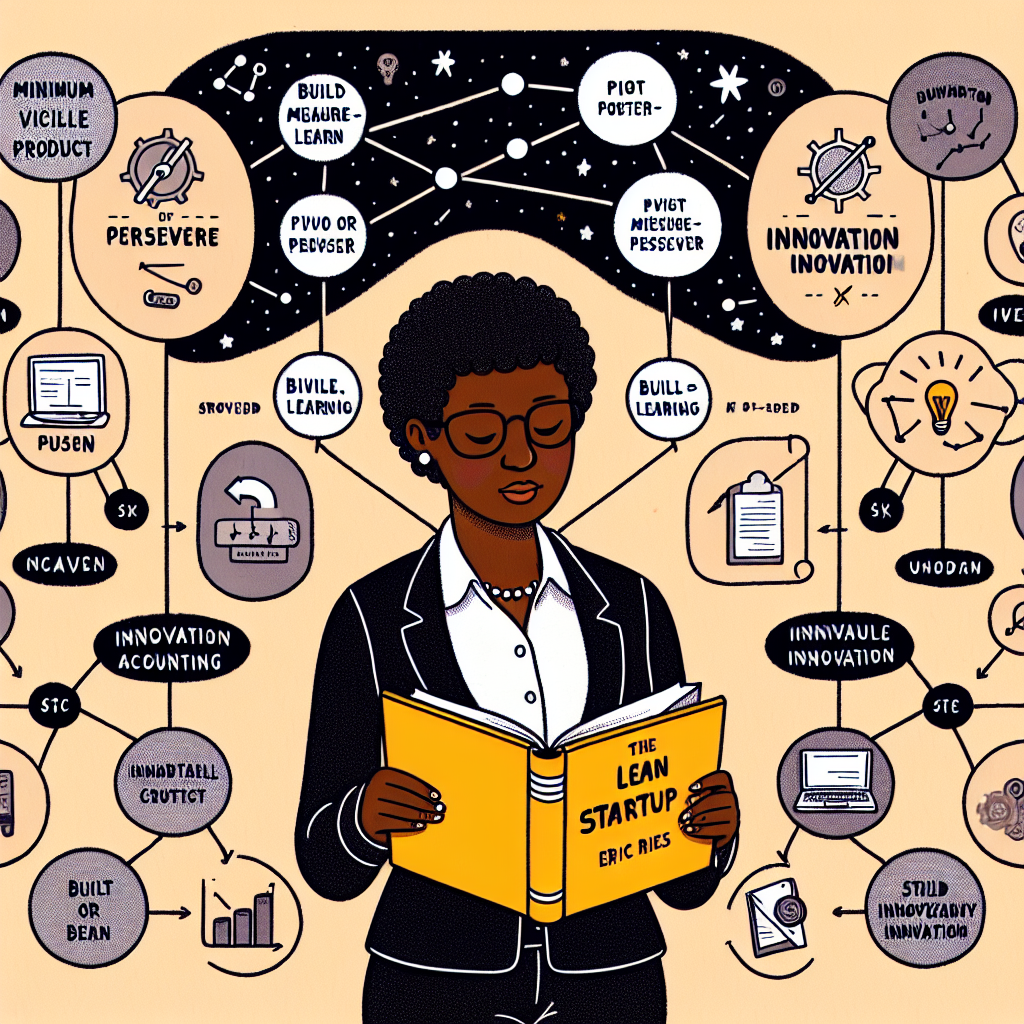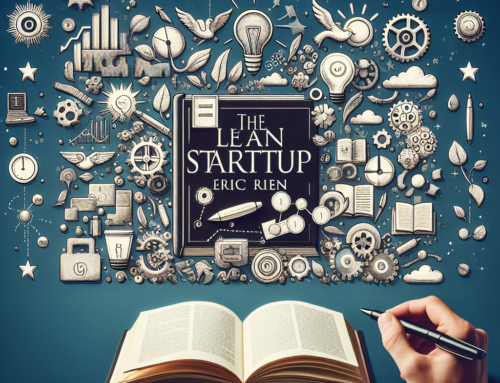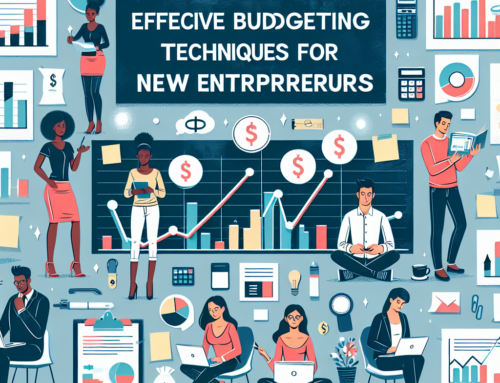
The Importance of Validating Your Ideas Before Launching
The Lean Startup by Eric Ries has become a must-read for entrepreneurs and business leaders alike. It offers valuable insights and practical advice on how to build a successful startup by focusing on continuous innovation and customer feedback. One of the key lessons from the book is the importance of validating your ideas before launching them into the market. In this section, we will explore why this is crucial and how you can effectively validate your ideas.
The traditional approach to starting a business involves creating a detailed business plan, securing funding, and then launching the product or service. However, this method is often time-consuming and expensive, and it assumes that the initial idea is perfect and will be successful in the market. The Lean Startup challenges this approach and emphasizes the need for continuous learning and adaptation.
The first step in validating your idea is to identify your target market and understand their needs and pain points. This involves conducting thorough market research and gathering feedback from potential customers. By doing so, you can ensure that your idea solves a real problem and meets the needs of your target audience. This step is crucial as it helps you avoid investing time and resources into an idea that may not have a market demand.
Once you have a clear understanding of your target market, the next step is to create a minimum viable product (MVP). An MVP is a basic version of your product or service that has enough features to satisfy early adopters. The purpose of an MVP is to test your idea in the market and gather feedback from real customers. This feedback is essential as it allows you to make improvements and pivot if necessary before investing more time and resources into the idea.
The Lean Startup also emphasizes the importance of the build-measure-learn feedback loop. This means that you should continuously build, measure, and learn from your MVP. By measuring the success of your MVP, you can gather valuable data and insights that will help you make informed decisions about your product or service. This feedback loop allows you to make necessary changes and improvements based on real customer data, rather than assumptions.
Another crucial aspect of validating your idea is to have a growth mindset. This means being open to feedback and willing to adapt and pivot if necessary. The Lean Startup encourages entrepreneurs to embrace failure as a learning opportunity and to constantly experiment and iterate their ideas. By having a growth mindset, you can avoid getting attached to your initial idea and be open to making changes based on customer feedback.
In addition to validating your idea with potential customers, it is also essential to validate it with investors. The Lean Startup suggests that entrepreneurs should focus on creating value for customers first, rather than seeking funding. By having a validated idea and a strong customer base, you can increase your chances of securing funding from investors.
In conclusion, The Lean Startup highlights the importance of validating your ideas before launching them into the market. By understanding your target market, creating an MVP, and continuously gathering feedback, you can ensure that your idea solves a real problem and meets the needs of your customers. Additionally, having a growth mindset and being open to feedback and adaptation is crucial for the success of your startup. So, before you invest time and resources into an idea, make sure to validate it first.
The Power of Iteration and Continuous Improvement
The Lean Startup by Eric Ries has become a must-read for entrepreneurs and business leaders alike. It offers a fresh perspective on how to build and grow a successful business in today’s fast-paced and ever-changing market. One of the key lessons from the book is the power of iteration and continuous improvement.
In traditional business models, companies spend months or even years developing a product or service before launching it to the market. This approach often leads to high costs, long development cycles, and a high risk of failure. The Lean Startup, on the other hand, advocates for a different approach – one that focuses on rapid iteration and continuous improvement.
The concept of iteration is simple – it involves creating a minimum viable product (MVP) and getting it in front of customers as soon as possible. This MVP is a basic version of the product or service that allows entrepreneurs to test their assumptions and gather feedback from real customers. This feedback is then used to make improvements and iterate on the product.
The Lean Startup emphasizes the importance of getting feedback from customers early on in the development process. This not only helps to validate the product idea but also allows for quick adjustments and improvements based on customer needs and preferences. By continuously iterating and improving the product, entrepreneurs can avoid wasting time and resources on developing a product that may not meet the market’s needs.
Another key aspect of the Lean Startup methodology is the concept of the build-measure-learn feedback loop. This loop involves building the MVP, measuring its performance, and learning from the data and feedback gathered. This process is repeated over and over again, with each iteration leading to a better and more refined product.
The build-measure-learn feedback loop is crucial in the Lean Startup approach as it allows entrepreneurs to make data-driven decisions. Instead of relying on assumptions and guesswork, entrepreneurs can use real data and feedback from customers to guide their decisions. This not only reduces the risk of failure but also leads to a more customer-centric product.
One of the key benefits of the Lean Startup’s focus on iteration and continuous improvement is the ability to pivot. A pivot is a change in direction based on the feedback and data gathered from customers. It could involve changing the product’s features, target market, or even the entire business model. By continuously iterating and gathering feedback, entrepreneurs can identify when a pivot is necessary and make the necessary changes before it’s too late.
The Lean Startup also emphasizes the importance of a culture of experimentation and learning. In traditional business models, failure is often seen as a negative outcome. However, in the Lean Startup approach, failure is seen as a learning opportunity. By embracing failure and using it as a chance to learn and improve, entrepreneurs can create a culture of experimentation and innovation within their teams.
In conclusion, the power of iteration and continuous improvement is a key lesson from The Lean Startup. By focusing on rapid iteration, gathering feedback from customers, and using data to drive decisions, entrepreneurs can create a more customer-centric and successful product. The build-measure-learn feedback loop and the ability to pivot also allow for flexibility and adaptability in today’s fast-paced market. By embracing a culture of experimentation and learning, entrepreneurs can increase their chances of success and build a sustainable and thriving business.
How to Effectively Utilize Minimum Viable Products (MVPs)
The Lean Startup by Eric Ries has become a must-read for entrepreneurs and business leaders looking to build successful and sustainable companies. One of the key concepts in the book is the use of Minimum Viable Products (MVPs) to test and validate business ideas. In this section, we will explore the key lessons from The Lean Startup on how to effectively utilize MVPs.
First and foremost, it is important to understand what an MVP is and why it is crucial for startups. An MVP is a version of a product with just enough features to satisfy early customers and provide feedback for future product development. It is not a fully developed product, but rather a prototype that allows entrepreneurs to test their assumptions and gather valuable insights from real customers. The main purpose of an MVP is to minimize risk and maximize learning.
One of the key lessons from The Lean Startup is the importance of building MVPs quickly and cheaply. Ries emphasizes the need for speed and efficiency in the MVP process. This means focusing on the core features that will provide the most value to customers and building them in the simplest and most cost-effective way possible. By doing so, entrepreneurs can quickly get their product in front of customers and gather feedback without wasting time and resources on unnecessary features.
Another crucial lesson from The Lean Startup is the importance of constantly iterating and improving MVPs based on customer feedback. Ries advocates for a Build-Measure-Learn feedback loop, where entrepreneurs build an MVP, measure its performance, and learn from the data to make improvements. This continuous cycle of iteration allows startups to adapt and pivot their product based on real customer needs and preferences. It also helps to avoid the common mistake of building a product in isolation without any customer input.
In addition to gathering feedback from customers, Ries also emphasizes the importance of tracking and analyzing data from MVPs. This data can provide valuable insights into customer behavior, preferences, and pain points. By using data to drive decision-making, entrepreneurs can make informed and data-driven decisions about their product and business strategy. This is a key aspect of the Lean Startup methodology, as it allows for a more scientific and evidence-based approach to building a business.
One of the most significant benefits of utilizing MVPs is the ability to test and validate assumptions before investing significant time and resources into a product. Ries encourages entrepreneurs to identify their riskiest assumptions and use MVPs to test them. By doing so, startups can avoid building a product that no one wants or needs, saving them from potential failure and wasted resources. This approach also allows for a more agile and flexible business model, where startups can quickly pivot and adapt based on customer feedback and data.
Lastly, The Lean Startup also emphasizes the importance of having a clear and defined vision for the product. While MVPs are meant to be simple and minimal, they should still align with the overall vision and goals of the company. This means having a clear understanding of the problem the product is solving and the target market it is serving. Without a clear vision, MVPs can become scattered and unfocused, leading to confusion and a lack of direction for the product.
In conclusion, The Lean Startup by Eric Ries offers valuable insights and lessons on how to effectively utilize MVPs in the product development process. By building MVPs quickly and cheaply, constantly iterating and improving based on customer feedback and data, and having a clear vision for the product, startups can minimize risk and maximize learning. MVPs are a crucial tool for any entrepreneur looking to build a successful and sustainable business, and The Lean Startup provides a comprehensive guide on how to use them effectively.
The Role of Customer Feedback in Shaping Your Product
The Lean Startup by Eric Ries has become a must-read for entrepreneurs and business leaders alike. It offers valuable insights and practical advice on how to build a successful startup by focusing on continuous innovation and customer feedback. In this article, we will delve into one of the key lessons from the book – the role of customer feedback in shaping your product.
In today’s fast-paced and ever-changing business landscape, it is crucial to have a product that meets the needs and desires of your target market. However, many startups make the mistake of assuming they know what their customers want without actually asking them. This is where the concept of customer feedback comes in.
Ries emphasizes the importance of getting feedback from your customers early and often. This means involving them in the product development process from the very beginning. By doing so, you can ensure that your product is aligned with their needs and preferences, and you can avoid wasting time and resources on building something that no one wants.
One of the key ways to gather customer feedback is through the use of Minimum Viable Products (MVPs). An MVP is a basic version of your product that allows you to test your assumptions and gather feedback from real customers. It is not a fully developed product, but rather a prototype that can be quickly and cheaply built. By releasing an MVP, you can get valuable insights from your customers and use that feedback to improve and iterate on your product.
Another important aspect of customer feedback is the concept of validated learning. This means using data and feedback from customers to validate or invalidate your assumptions about the product. Ries stresses the importance of not falling into the trap of confirmation bias, where you only seek out feedback that supports your assumptions. Instead, you should actively seek out feedback that challenges your assumptions and use that to make informed decisions about your product.
One of the key benefits of incorporating customer feedback into your product development process is the ability to pivot. A pivot is a change in direction based on customer feedback and data. It allows you to adapt and evolve your product to better meet the needs of your customers. By continuously gathering feedback and making pivots, you can create a product that is truly customer-centric and has a higher chance of success in the market.
However, it is important to note that not all customer feedback should be taken at face value. Ries advises entrepreneurs to look for patterns and trends in the feedback rather than individual opinions. This will help you identify the underlying problems or needs that your customers have, rather than just addressing surface-level issues.
In addition to gathering feedback from customers, Ries also emphasizes the importance of building a feedback loop within your team. This means creating a culture of open communication and continuous improvement. By encouraging team members to share their ideas and feedback, you can foster a collaborative environment where everyone is working towards the same goal – creating a successful product.
In conclusion, customer feedback plays a crucial role in shaping your product and increasing its chances of success. By involving customers in the product development process, using MVPs, and practicing validated learning, you can create a product that truly meets the needs and desires of your target market. Additionally, building a feedback loop within your team can lead to a more collaborative and innovative work environment. As Eric Ries says, ”The only way to win is to learn faster than anyone else.” So, make customer feedback a priority in your startup journey and watch your product evolve into a success.
Implementing Lean Startup Principles in Established Companies
The Lean Startup by Eric Ries has become a must-read for entrepreneurs and business leaders alike. Its principles have revolutionized the way startups approach product development and have led to the success of many companies. However, the book is not just for startups. Established companies can also benefit from implementing the lean startup principles in their operations.
One of the key lessons from The Lean Startup is the importance of validated learning. This means constantly testing and validating assumptions about the product or service being developed. In established companies, there is often a tendency to rely on past successes and stick to traditional methods. However, this can lead to complacency and a failure to adapt to changing market conditions. By implementing the lean startup principle of validated learning, established companies can stay ahead of the curve and continuously improve their products and services.
Another important lesson from The Lean Startup is the concept of the minimum viable product (MVP). This is the most basic version of a product that can be released to the market to gather feedback and validate assumptions. In established companies, there is often a focus on perfection and releasing a fully developed product. However, this can lead to wasted time and resources if the product does not meet the needs of the market. By adopting the lean startup approach of releasing an MVP, established companies can gather valuable feedback from customers and make necessary improvements before investing more time and resources into the product.
The lean startup principle of pivoting is also crucial for established companies. Pivoting means making a significant change in the product or business model based on customer feedback and market trends. In established companies, there is often resistance to change and a fear of deviating from the original plan. However, as Ries emphasizes in his book, pivoting is not a sign of failure but rather a necessary step towards success. By being open to pivoting, established companies can adapt to changing market conditions and stay relevant in their industry.
One of the biggest challenges for established companies when implementing lean startup principles is the fear of failure. In a traditional business setting, failure is often seen as a negative outcome and something to be avoided at all costs. However, in the lean startup approach, failure is seen as a learning opportunity. By embracing failure and using it as a chance to gather valuable insights, established companies can continuously improve and innovate.
Another important aspect of the lean startup approach is the concept of the build-measure-learn feedback loop. This involves building a product, measuring its performance, and learning from the results to make necessary improvements. In established companies, there is often a focus on building a product and then moving on to the next project without taking the time to gather feedback and make improvements. By implementing the build-measure-learn feedback loop, established companies can ensure that their products are meeting the needs of their customers and continuously improving.
Finally, one of the key takeaways from The Lean Startup for established companies is the importance of a culture of innovation. In traditional companies, there is often a top-down approach where decisions are made by a few individuals at the top. However, the lean startup approach encourages a culture of experimentation and innovation where ideas can come from anyone in the company. By fostering a culture of innovation, established companies can tap into the creativity and ideas of their employees and stay ahead of the competition.
In conclusion, The Lean Startup by Eric Ries offers valuable lessons for established companies looking to stay competitive in today’s fast-paced business world. By implementing the lean startup principles of validated learning, MVP, pivoting, embracing failure, the build-measure-learn feedback loop, and fostering a culture of innovation, established companies can continuously improve and adapt to changing market conditions. As Ries says, ”The only way to win is to learn faster than anyone else.” By adopting the lean startup approach, established companies can do just that and achieve long-term success.
We have lots of exciting coming events in Entrepreneurship, Investing and Personal Development. You can find them all here:
www.swedishwealthinstitute.se/events




